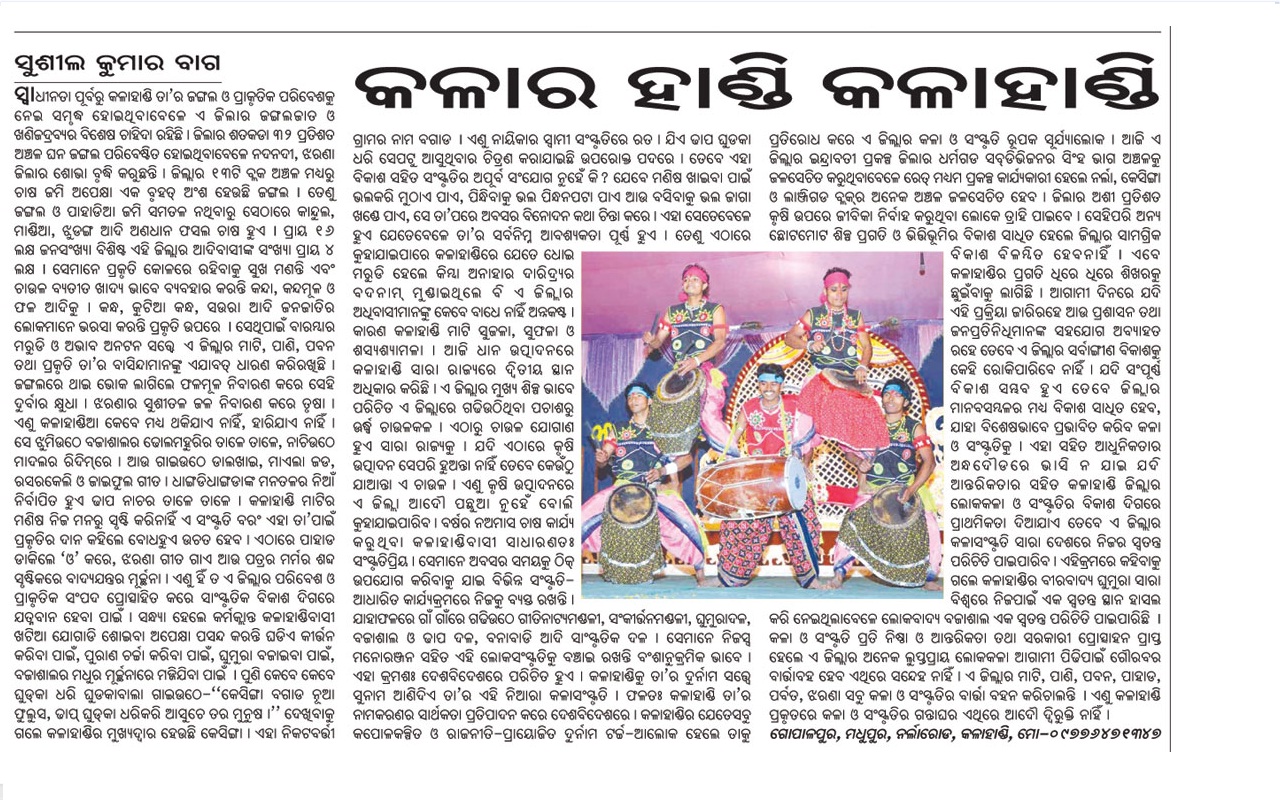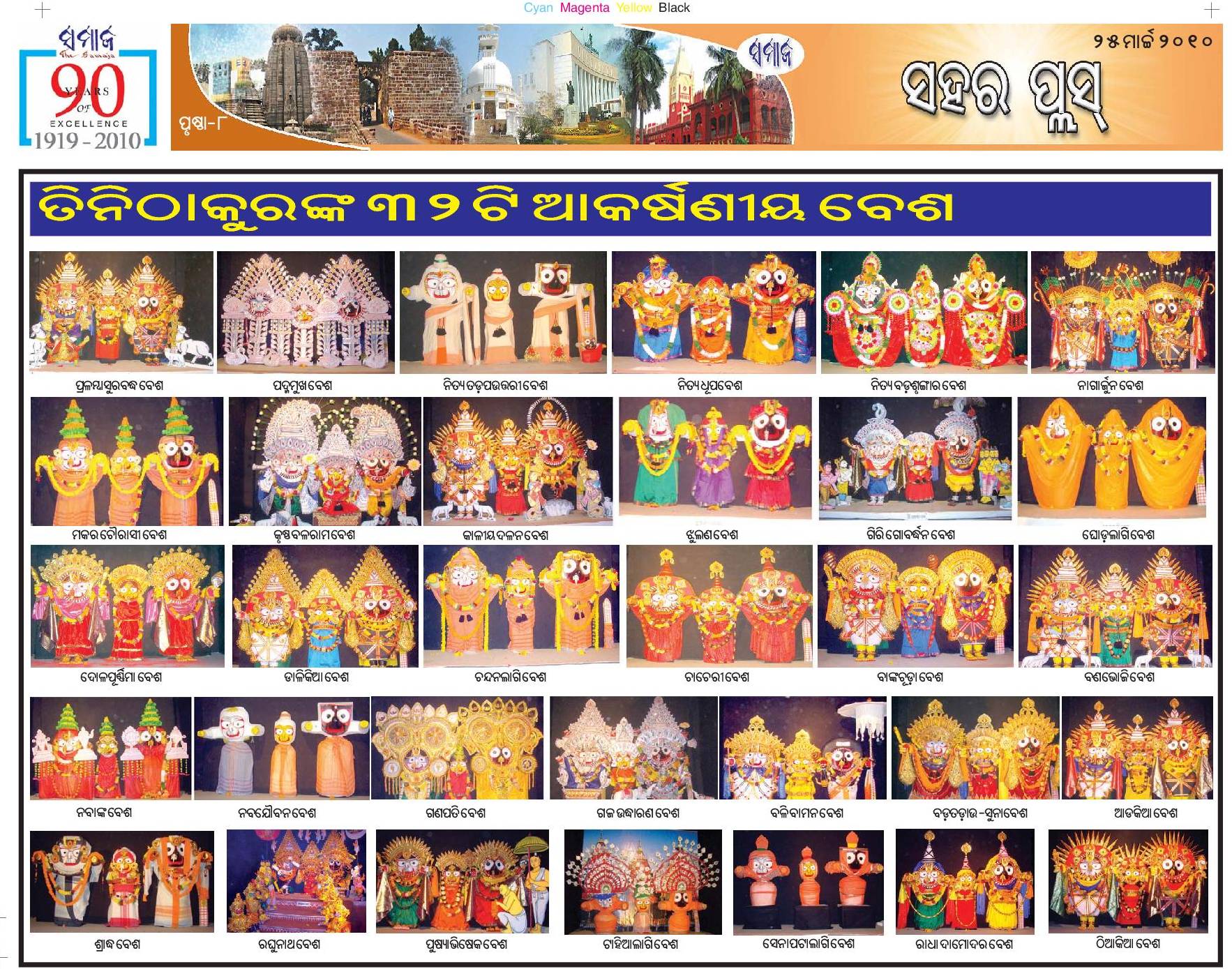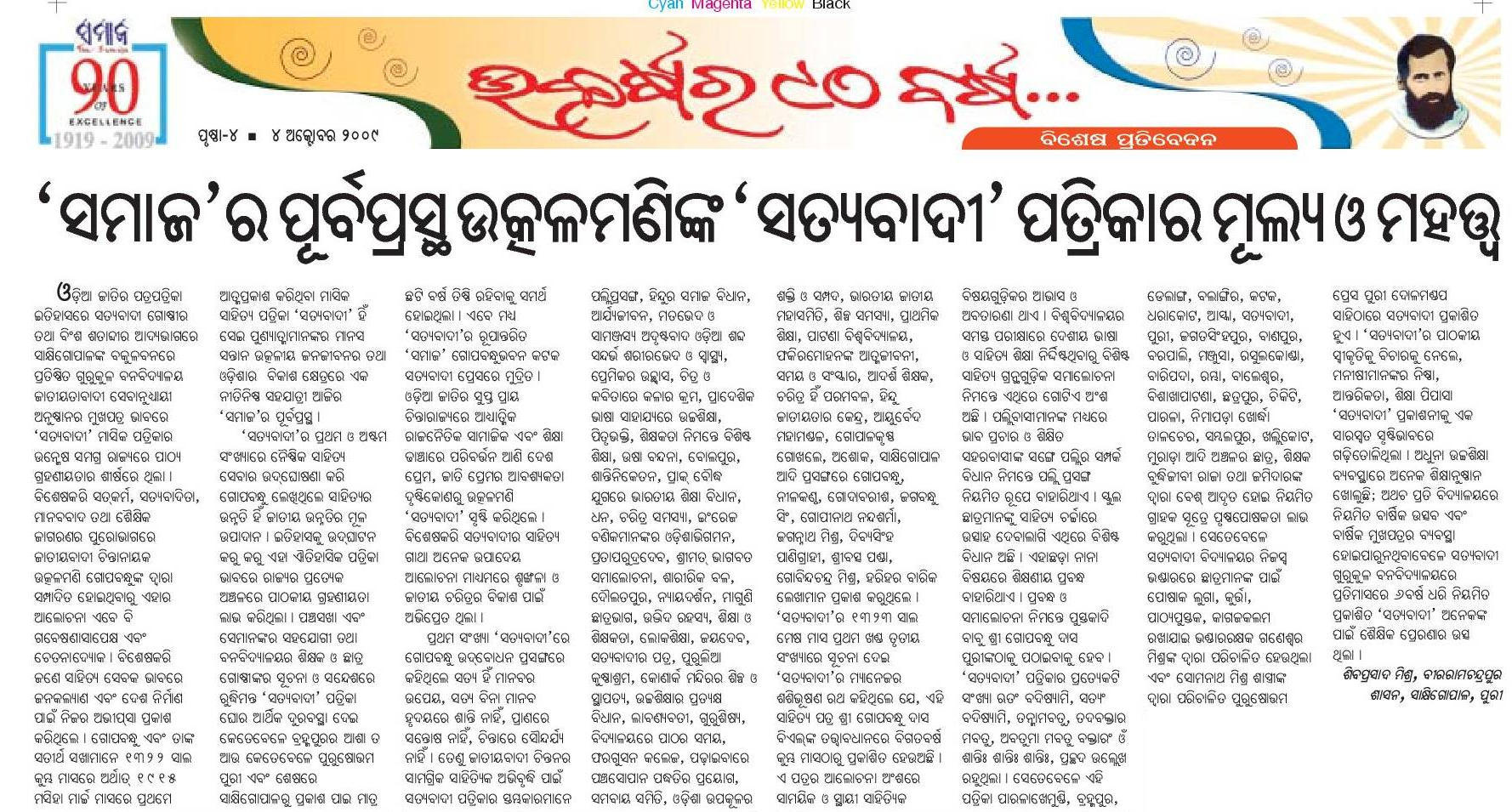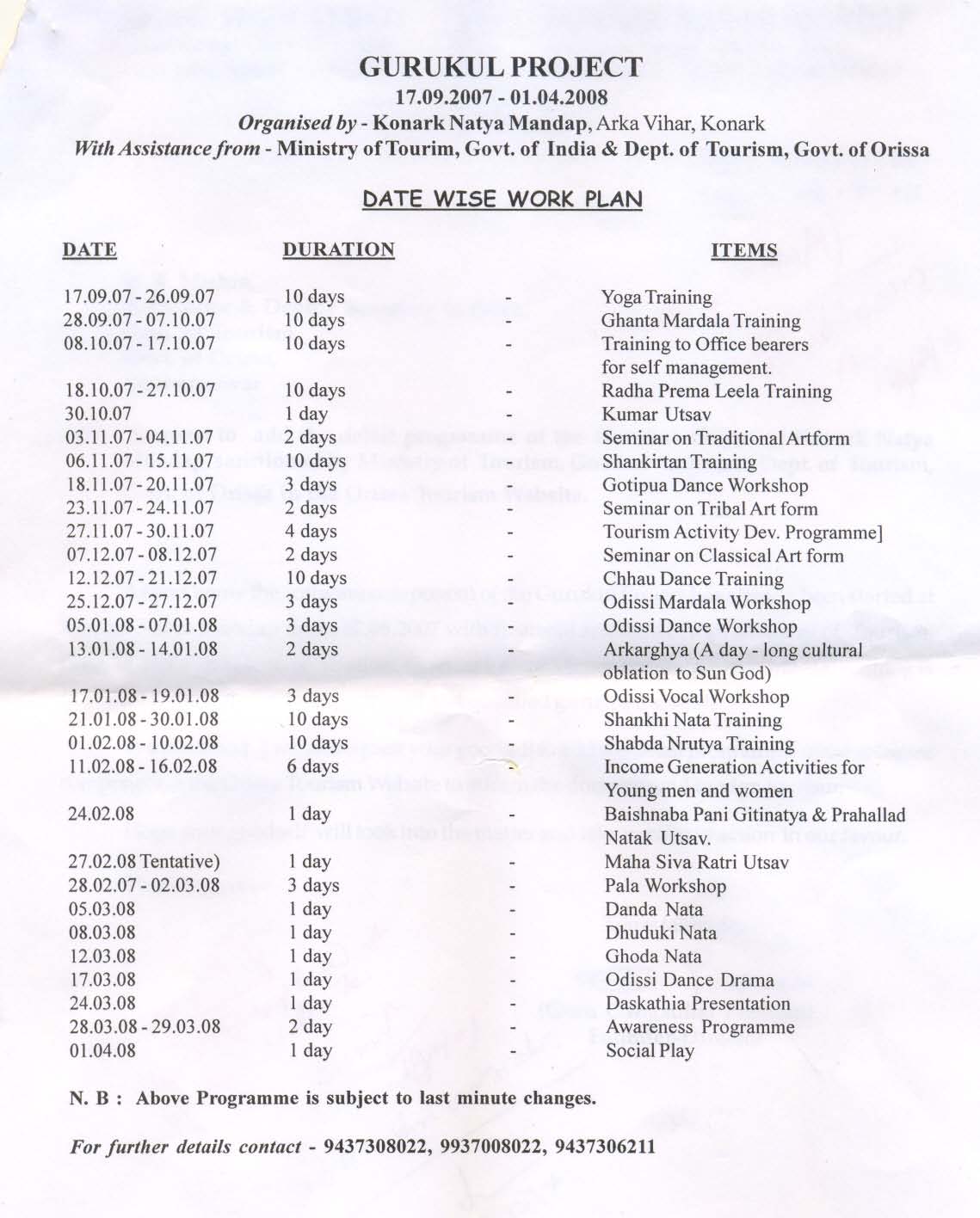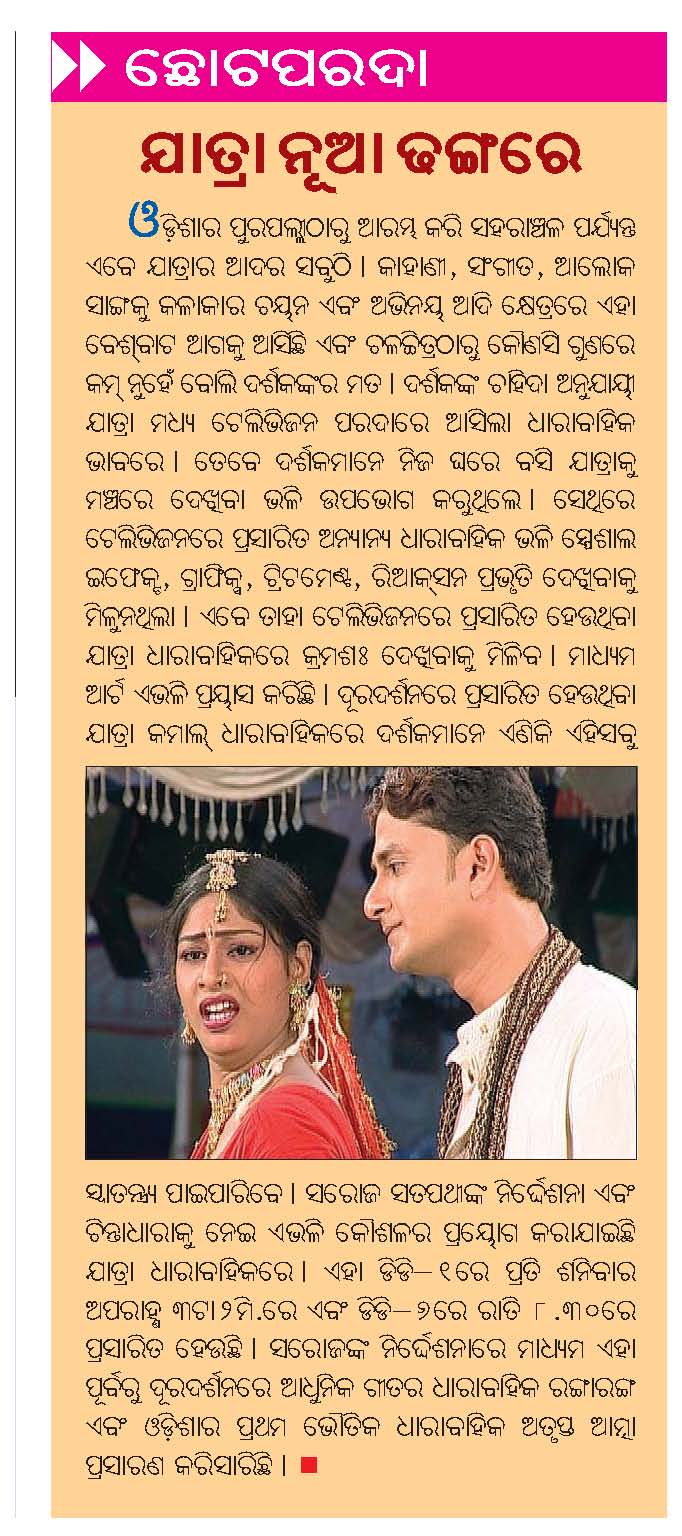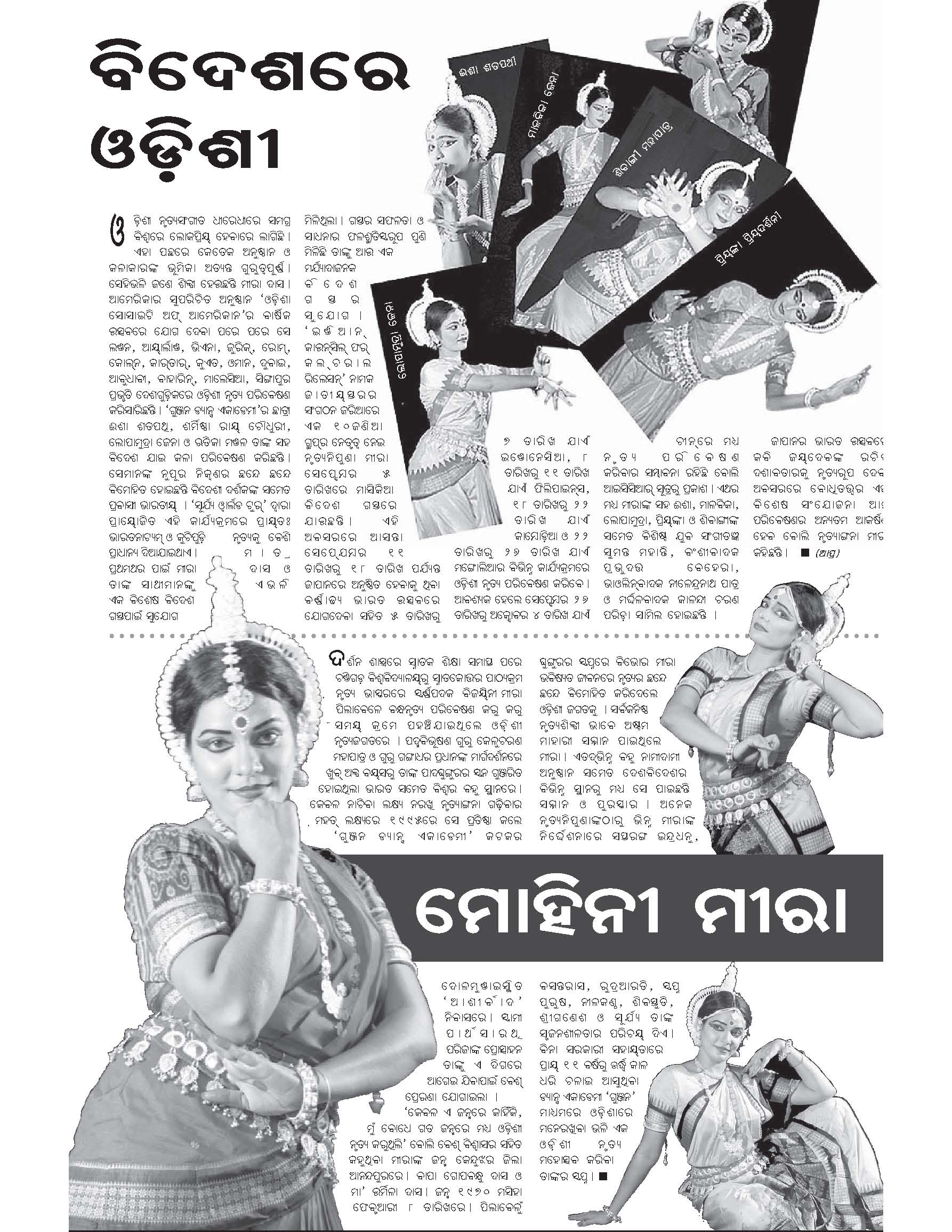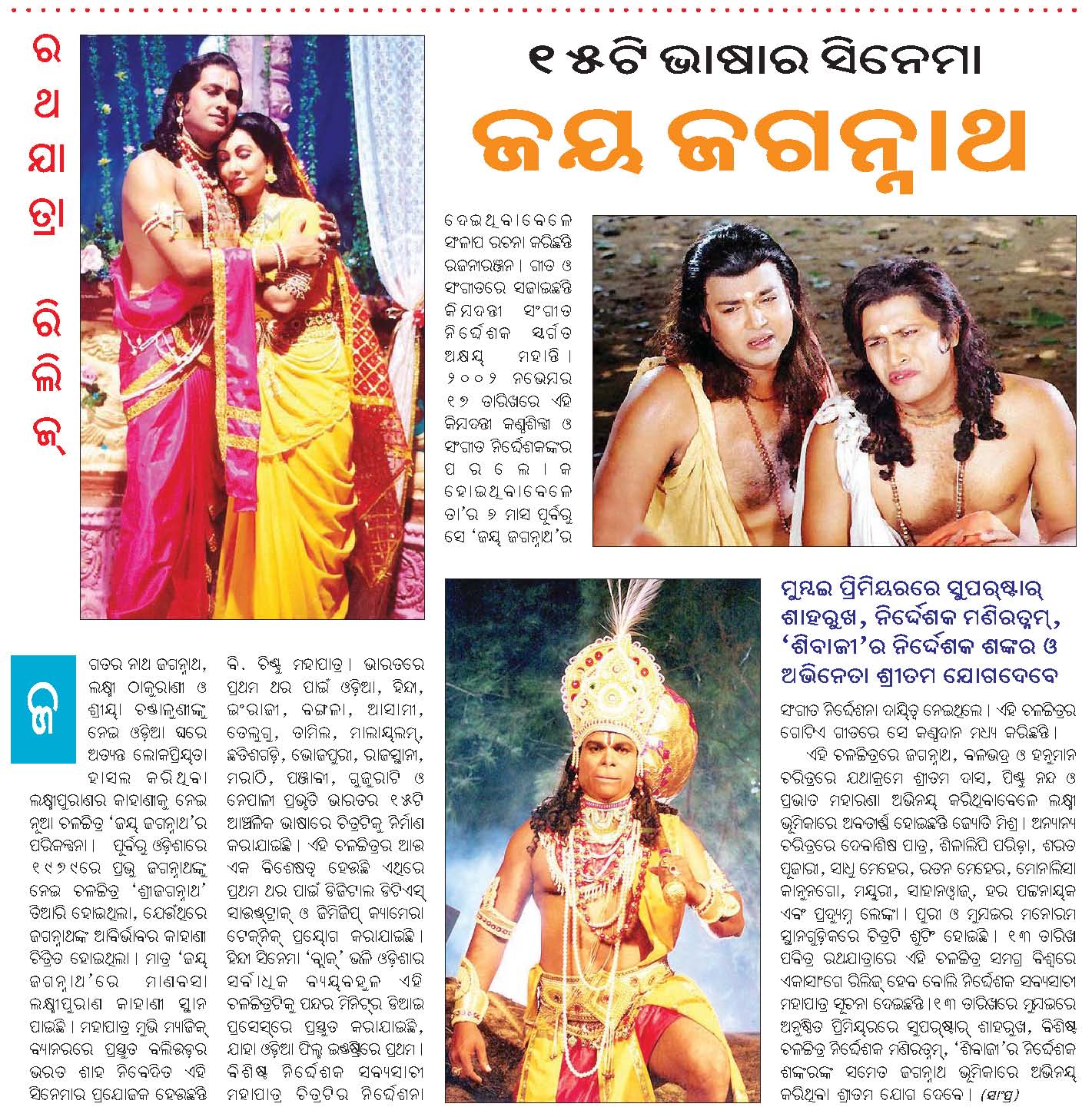Archive for the 'Odisha Culture' Category
Debabrata Mohanty pays tribute to Guru Gangadahara Pradhan in Indian Express
Konark Festival, Odisha Culture, Odisha personalities, Odissi 1 Comment »Following is from http://www.indianexpress.com/news/end-of-a-dance-odyssey/698852/0.
Had it not been for his parents, Gangadhar Pradhan, renowned exponent of Odissi, who died at a private hospital in Bhubaneswar last Monday, would perhaps never have chosen the dance form. Moments after he was born at Parikul, a remote village of Puri district in 1948, Gangadhar did not cry, leading to fears that he may be stillborn. Gangadhar’s peasant father, Muralidhar Pradhan, and mother, Dwitika Devi, had already lost their three sons and two daughters earlier. Muralidhar vowed that if this child survived, he would serve the presiding deity, Lord Balunkeshwar, at Dimirisena village in Puri district, for five years.
Gangadhar survived, and at the age of six years he was sent to the temple at Dimirisena, where he went through a rigorous training in Gotipua (literally meaning one boy) dance, under the direct guidance of Pandit Chandrasekhar Pattnaik.
If the late Kelucharan Mohapatra made Odissi popular to the outside world, Gangadhar, one of his first disciples, was instrumental in carrying the dance form forward and giving it institutional support. A purist to the core like his guru, Gangadhar honed his skill at playing the mardal (a percussion instrument) by learning from Singhari Shyama Sundar Kar and Guru Banamali Maharana. He learnt the text of Odissi dance from well-known scholar Dhirendra Nath Patnaik. His alma mater, Utkal Sangeet Mahavidyalaya, also played a significant role in shaping Gangadhar, who matured into a dancer-choreographer of great sensitivity and skill.
Gangadhar was the proverbial sculptor, hammering away day and night to keep the dance form robust and popular. “As a teacher, he never ran away from Odissi’s pure traditions. He was always grammatically correct and would not do anything that messed up the basic fabric of the dance form,” said noted danseuse Kumkum Mohanty.
While Kelucharan crafted his own style, Gangadhar did not follow any particular style. But it was his vision to establish Odissi as a strong art form that distinguished him from other Odissi legends.
In the late ’70s, the life of a performing artist, particularly that of a dancer, was difficult to say the least. But instead of giving up, Gangadhar came up with the idea of starting an institution. In 1975, he started the Odissi Dance Academy, later re-christened as the Orissa Dance Academy (ODA).
The academy in Bhubaneswar is the single biggest repository of Odissi dance talent, having produced over 1,000 renowned dancers so far. “In the world of Odissi, you pick any known dancer today and chances are that he/she would be a product of the ODA,” says dance critic Shyamahari Chakra. Not surprisingly, there are 35 Odissi dance schools in the world affiliated to the ODA. But his unceremonious exit a few years ago hurt him badly.
Always on the lookout for ways to popularise Odissi, Gangadhar hit upon the idea of expanding its reach through festivals. One thing that always bothered him was that Odissi dancers in Orissa did not have a platform in their own state. So, in 1986, he started the first Konark Dance & Music Festival at the Konark Sun Temple and formed the Konark Natya Mandap. The Konark Natya Mandap is now an international centre where training in Odissi, Gotipua, Chhou, Pala, vocal and instrumental music are imparted to youngsters. Several years ago, Gangadhar started the Dhauli Dance Festival. Besides these, he also started several small dance festivals such as Nimapara Dance Festival, Chilika Dance Festival, Kalinga Kala Utsav, Basanta Utsav, Boita Bandana Utsav, Bhaunri Utsav, etc. The annual Chitralekha Dance Academy Festival in Canada was also held under his stewardship.
Danseuse Aruna Mohanty, one of his first disciples, says Gangadhar was a visionary. “He found teaching Odissi his true calling,” said Mohanty.
Guru Gangadhar Pradhan and Konark Natya Mandap
Odia music, Odisha artists, Odisha Culture, Odisha dances, Odisha personalities, Puri Comments Off on Guru Gangadhar Pradhan and Konark Natya MandapFollowing is an excerpt from an article in Deccan Herald.
“My mother-in-law and social worker Sushilavati Swain asked me to start some cultural activity in Konark, so we acquired a piece of land in 1978. Two years later, we built a mud hut and called it the Konark Nata Mandap. Every Sunday we had a meeting and artistes from the nearby areas would come and spend the entire day singing, dancing and playing various musical instruments,” Gangadhar Pradhan says. This created an ambience of culture. The mandap’s activity started in 1980 as a small get-together but soon there was no looking back as it paved the way for the five-day international Konark Dance and Music Festival, that is held every year in this small town of Orissa.
Besides, the Konark Nata Mandap was re-christened Konark Natya Mandap (KNM). It has undergone several changes over the years. And, it has finally taken the shape of the replica of the world famous Sun Temple.
“The festival started in 1986 on the day of Shivaratri. But the seeds of the festival were sown in my mind when I had gone to the Swedish embassy and saw posters of the Khajuraho Festival there. That’s how the idea of the Konark Dance and Music Festival took shape in my mind,” remarks Pradhan.
In the true sense, it was the harbinger of the contemporary festivals of Odisha. “The main objective of the festival is not merely to provide entertainment but to educate and refine. It aims to harmoniously blend the classical, spiritual, tribal and folk aspects of the glorious cultural traditions.”
Built through the painstaking efforts of Gangadhar Pradhan, KNM now is a performer’s delight. A replica of the natyashala of the scintillating and stupendous Sun Temple of Konark, it provides the right kind of ambience for artistes, connoisseurs and art lovers from India and abroad.
The KNM serves as a temple of learning. Following the glorious traditions of Guru Kula Parampara, it provides teaching and training in dance, music, yoga and theatre. Classes on Odissi dance, Gotipua dance, mardal, tabla and Odissi music are being conducted on its premises. Experienced gurus and teachers share their experience with students who get the privilege of presenting their skill on the three stages erected on the premises.
That apart, KNM is functioning as an institution of cultural consultancy in the state for the growth and propagation of Odissi, tradition and classical art forms both at national and international levels. The mandap has shouldered a big responsibility of popularising Odissi dance and the sculptural epic Konark has metamorphosed into a living Konark.
Talking about his dream, Gangadhar Pradhan says that something should be happening in KNM throughout the year. “Now there is a festival happening 220 days in a year.” He is confident of achieving his goal by the middle of this decade.
Explaining about Living Konark, he said that people had seen Konark in stone, now they would see the living Konark and the dancing Konark. Once, this dream materialised, there would be a computerised film on Konark that would be screened.
“When I had given wings to my imagination, I had dreamt of the future 1000 years’ history which takes into account the cultural, spiritual and ritualistic aspects. The triangle of Konark-Puri-Bhubaneswar-Chilka will develop tourism as well as culture. What the tourist sees in one place will not be repeated in other places, so he or she will get to see something new each time,” he added.
Team Odisha presentations during their June-July visit to USA
HRD-n-EDUCATION (details at orissalinks.com), INDUSTRY and INFRASTRUCTURE, Odisha Culture, Odisha govt. action, Ports and waterways, Team Odisha Comments Off on Team Odisha presentations during their June-July visit to USAFollowing are presentations given by the Odisha delegation that visited US during June-July 2010.
- 2010 Industry Status. (4.2MB)
- 2010 Port Status. (3.7MB)
- 2010 Culture and Education scenario. (1.9MB)
- 2010 Higher Education Opportunities. (250 KB)
Eastern zonal Cultural center has all its infrastructure in West Bengal
Central govt. schemes, Demanding equitable treatment, Jatra, Odia music, Odisha artists, Odisha Culture, Odisha dances, Odisha govt. Inaction, Palla and Daskathia, Puppetry 1 Comment »Following is from the PIB http://pib.nic.in/release/release.asp?relid=62636 which brought our attention to the zonal cultural centers funded by the Ministry of Culture, Government in India. By looking at the web page of the Eastern Zonal Cultural Center in Kolkata, it seems like all of the infrastructure of this center is in West Bengal.
The aims and objectives of the Zonal Cultural Centres (ZCCs) are to preserve, promote and disseminate the arts, specially folk/tribal arts of the country. The ZCCs endeavour to develop and promote the rich diversity and uniqueness of various arts of the Zone and to upgrade and enrich consciousness of the people about their cultural heritage.
There are only seven ZCCs in the country. Though no ZCC has its headquarters in Karnataka, the state of Karnataka is a member of the South Zone Cultural Centre (SZCC), having its headquarters at Thanjavur and also of South Central Zone Cultural Centre (SCZCC) having its headquarters at Nagpur.
The details of ZCCs, location-wise and the schemes/programmes organised/executed by each centre, ZCC-wise are annexed.
Annexure
Government has set up seven Zonal Cultural Centres (ZCCs) having headquarters in various part of the country as per the details given below:-
|
Sl. No. |
Name of the centre |
Headquarters |
Member States |
|
1 |
North Zone Cultural Centre |
Patiala |
Jammu & Kashmir, Himachal Pradesh, Punjab, Haryana, Uttarakhand, Rajasthan and Union Territory of Chandigarh |
|
2. |
West Zone Cultural Centre |
Udaipur |
Rajasthan, Maharashtra, Gujarat, Goa, Union Territories of Daman & Diu and Dadra & Nagar Haveli |
|
3 |
South Zone Cultural Centre |
Thanjavur |
Andhra Pradesh, Karnataka, Kerala, Tamil Nadu, Union Territories of Andaman & Nicobar Islands, Lakshadweep, Puducherry. |
|
4 |
South Central Zone Cultural Centre |
Nagpur |
Andhra Pradesh, Chhattisgarh, Karnataka, Madhya Pradesh and Maharashtra |
|
5 |
Eastern Zonal Cultural Centre |
Kolkata |
Assam, Bihar, Jharkhand, Manipur, Orissa, Sikkim, Tripura, West Bengal and Union Territory of Andaman and Nicobar Islands. |
|
6 |
North Central Zone Cultural Centre |
Allahabad |
Uttar Pradesh, Madhya Pradesh, Bihar, Haryana, Rajasthan, Uttarakhand and NCT of Delhi. |
|
7 |
North East Zone Cultural Centre |
Dimapur |
Arunachal Pradesh, Assam, Manipur, Meghalaya, Mizoram, Nagaland, Sikkim and Tripura. |
The ZCCs have been carrying out various activities in accordance with their aims and objectives:-
I. National Cultural Exchange Programme: With a view to present art forms of one region to another and expose the diverse cultural heritage of each region to the rest of the country, the folk/tribal artistes are sent on exchange manner to participate in the programmes organized by the seven Zonal Cultural Centres.
II. Guru Shishya Parampara Scheme: The Scheme was introduced in 2003-04 with a view to promote development of new talents in the field of music and dance, folk and tribal art forms, under the able guidance of Gurus.
III. Young Talented Artistes Scheme: The Scheme was introduced during the year 2004-05 to recognize and encourage young talents in the various Folk/Tribal arts forms in different regions in the country.
IV. Documentation of Vanishing Art Forms: Under the Scheme, documentation of various folk and tribal art forms is undertaken, especially of those which are seen to be vanishing.
V. Shilpagram Activities: ZCCs have set up Shilpagrams at Chandigarh, Khajuraho, Udaipur, Guwahati, Allahabad and Shantiniketan to encourage various forms of folk/tribal arts and crafts from rural India. These Shilpagrams are attracting a large number of domestic as well as foreign visitors. Through these Shilpgrams, a number of artistes and artisans are benefited and a large number of people are made aware of our rich cultural heritage.
VI. Loktarang – National Folk Dance Festival and OCTAVE – Festival of the North East: All the ZCCs participate in these National level festivals organized every year in New Delhi and/or other places. A large number of folk/tribal artistes from all corners of the country performs during these festivals to showcase the diverse folk/tribal arts of our country.
Following is from the "About Us" page of the Eastern Zonal Cultural Center.
The idea for Zonal Cultural Centers germinated in the mind of our late Prime Minister, Rajiv Gandhi. At his instance, several centers were set up. They represent the effort on the part of the Government and the people to preserve and protect our rich cultural heritage and to bring it closer to the lives of the people. With each State or Union Territory belonging to at least one Zonal Center, the objective is to foster amongst the people within each zone and among zones, much greater cultural exchanges and understanding. This not only results in a better understanding of our heritage but also brings out the underlying unity of our diverse cultural traditions.
A self-transforming civilization that defies any attempt to freeze it in space and time, living India is a mosaic of varied cultures, layer upon layer, tempered in a history of a common vitality.
Since independence, it has been the concern of the Government of India to encourage the evolution and consolidation of Indian culture by bringing its different streams closer and by making people of various regions know and understand each other’s distinctive traits in a spirit of appreciation and acceptance of the unity in diversity within this country.
The establishment of the Zonal Cultural Centers, in collaboration with the State Governments and Union Territories, is one of the measures taken by the Government of India to achieve this objective.
The Eastern Zonal Cultural Center (EZCC) covering the states of Assam, Bihar, Jharkhand, Manipur, Orissa, Sikkim, Tripura, West Bengal and The Union Territory of The Andaman and Nicobar Islands is one of the seven such Zonal Cultural Centers set up by the Government of India with a view to culturally integrate the states and Union Territories as a part of the program of national integration.
Since its inception in 1985 the EZCC has been functioning as a cultural nerve center, between and among the numerous ethnic cultural centers/groups of excellence of the eastern parts of the country. The Center strives through its various activities to enrich, promote and strengthen these traditions. The Center is totally dedicated to the promotion, projection and dissemination of our traditional culture.
Over the past several years, the EZCC has been able to infuse among people a conscious appreciation of the rich cultural heritage of its own zone as well as other parts of the country through its manifold programs of folk, tribal and classical dance music and dance, documentation and publication, workshops, as well as its exhibitions on arts and crafts.
The numerous fairs and festivals, seminars and symposia organized through out the year are efforts to combat the constant onslaught of the electronic media.
The Center is under the overall supervision of the Department of Culture, Ministry of Tourism and Culture, Government of India and is headed by the Director. His Excellency the Governor of West Bengal is the chairman of the EZCC.
The more we try to unravel the mysteries of our own many splendoured culture, the more we perceive the underlying strength of unity and harmony that rises above all differences and distinctions and enmeshes us in its inherent bonds. This is what we are committed to project and promote.
The following is from the Infrastructure page of the Eastern Zonal Cultural Center.
A. The Bharatiyam Cultural Multiplex is situated at IB-201, Sector III, Salt Lake City, Kolkata 700106.
The facilities available at the Bharatiyam Cultural Multiplex include
- Purbashree (Main Auditorium)
Air conditioned auditorium measuring 7850 square feet, having a capacity for over 900 persons.

- Rangmanch (Open Air Theatre)
Open Air Theatre measuring 4000 square feet has been built with a seating capacity of about 400 people. - Naat Ghar (Studio Theatre)
Air conditioned studio theatre measuring 1200 square feet has a seating capacity for 100 persons. - Sobha Ghar (Art Gallery)
The air-conditioned art gallery measures 3280 square feet. The exhibition wall is provided with track lighting.
 |
 |
 |
 |
 |
 |
 |
 |
 |
  |
|
|
 |
|
- Food Court
The open air Food Court measuring 2000 square feet with its ethnic background is an ideal place for hosting food festivals etc.
B. The Aikatan Cultural Center is situated at IA-190, Sector III, Salt Lake City, Kolkata 700097.
The facilities available at the Aikatan Cultural Complex include
|
 |
C. SRIJANI, the Shilpagram Complex of the EZCC is situated in Santiniketan, Bolpur in Birbhum District of West Bengal.
| This unique cultural center provides a conducive and infrastructure to nurture our traditional arts and crafts.
The complex comprises of huts, representative of EZCC’s member states. The huts incorporate traditional architectural features and design. |
|
The question is if the Eastern Zonal Cultural Center is supposed to cater several states in the Eastern part of India, including Odisha, why is all of its infrastructure in West Bengal.
This means the system of zonal cultural center is not working. The GOI must exapnd it to all major states and establish a similar center in Odisha. Odisha CM must lobby for it and make sure it is included in the next five year plan starting from 2012.
Utkalmani Gopabandhu’s Satyabadi magazine, the precursor of Samaja
Odia literature, Odisha Culture, Odisha history, Samaja (in Odia) Comments Off on Utkalmani Gopabandhu’s Satyabadi magazine, the precursor of SamajaNatya Chetana impresses in National Theater Festival, Kolkata
Jatra, Odisha artists, Odisha Culture, Odisha theatre 1 Comment »Following is an excerpt from a report in Telegraph.
Gently slipping into its silver edition, Nandikar’s National Theatre Festival must receive a standing ovation for persevering annually over 25 years, providing Calcuttans the only sustained platform to see a wide spectrum of Indian theatre. Even if some invitees have proved substandard recently, even if the full houses caused by serpentine overnight queues in the past have vanished thanks to TV, the organizational achievement remains undiminished.
Almost without fail, at least one surprise every year has won us over. This time, Natya Chetana (from outside Bhubaneswar) did the trick with dramatist-director Subodh Pattanaik’s Mati in Oriya, though we might have expected it on the strength of their Katha in 2002. Among those few Indian troupes to live and work on a rural commune, Natya Chetana admirably pursues theatre for social development. Mati (both earth and mother) manages to connect all of India’s present woes, perhaps too causally, but nonetheless passionately. An American in top hat and stars-and-stripes (an unnecessarily simplistic demonization, the only flaw) sells hybrid seeds to farmers through politicians and middlemen; eventually yields suffer and the villagers are exploited, paving the way for Maoist intervention and violence. The grounds for the spread of insurrection are sympathetically delineated. The collective performs energetically (especially the main family, in the picture) and Pattanaik designs another trademark bamboo-and-cloth set, made exclusively of natural material.
Two new theatre halls planned for Bhubaneswar: Sambada
Bhubaneswar- Cuttack- Puri, Khordha, Odisha Culture, Odisha dances, Sambada (in Odia), Theatre Comments Off on Two new theatre halls planned for Bhubaneswar: SambadaGurukul project: Organized by Konark Natya Mandap, Konark
Arts n crafts, Chhau, Festivals, Jatra, Konark, Odia music, Odisha Culture, Odisha dances, Odisha theatre, Odissi, Palla and Daskathia, Tourist promotion Comments Off on Gurukul project: Organized by Konark Natya Mandap, KonarkOdissi abroad – a Samaja article on the Mira Das group
Odisha Culture, Odissi Comments Off on Odissi abroad – a Samaja article on the Mira Das groupFollowing are excerpts from a New Indian Express report.
‘Kendera geeta’ is on the verge of extinction. This art form was once quite vibrant in Western Orissa districts.
Kendera geeta involves a particular group of people who sing devotional songs accompanied by a very simple-looking musical instrument. They visit door to door and seek alms to sustain themselves. Kendera has some similarity with violin.
There is a head made of dry coconut shell. A bunch of hair from horse’s tail is used as strings for the instrument.
The Naths have made kendera singing a profession and been carrying on with it as a family tradition. Naths migrated from Angul at different points of time to Nathpada of Dadar Nuapali and Parmanpur village of this district.
Interest in Kendera Geeta is gradually waning and now there is hardly any youth taking to the art form. The new generation considers carrying the crude instrument and seeking alms below their dignity. …
If this art is to be saved, it has to divorce itself from seeking alms.
Periphery development around Konark and other culture related projects
Historical places, Odisha Culture, Puri Comments Off on Periphery development around Konark and other culture related projectsNew Indian Express has a report on this. Following are some excerpts.
The Centre will invite global tender through the Archaeological Survey of India (ASI) for the preservation of the 13th century heritage Sun temple at Konark.
…
The Centre would release Rs 13 crore for the project as well as periphery development around the Sun temple.
…
the Centre has sanctioned Rs 1 crore for the renovation and development of the State museum at Bhubaneswar. Besides, Rs 92 lakh has also been earmarked for construction of the open theatre, Kalamandal, here.
…
The ASI, NCF, the Indian Oil Corporation (IOC) and Indian Oil Foundation have signed a memorandum of understanding (MoU) for five important monuments of India – Sun temple, Konark, Kanheri caves, Mumbai, Group of temples at Khajuraho, monuments at Hampi and Warangal Fort. The IOC has contributed Rs 25 crore for the project.
Samaja: Jai Jagannath releases in 15 languages
Odisha Culture Comments Off on Samaja: Jai Jagannath releases in 15 languagesWritings in oDiA script
Odia language resources, Odia literature, Odisha Culture, Writings in oDia script Comments Off on Writings in oDiA scriptThe Orissa government web site currently has the following classics in oDiA script.
The site http://www.odia.org/ also has several books and pages in oDiA script.
- Gita Gobinda: By Jayadeba
- Taapoi: Khudurukuni
- Sabitri: Savitri Brata Katha
- Paita Mantra: Jajrubediya
- Kaluribenta: Kaluri Benta Katha
- Mo patha bahi
- oDiA cheat sheet
Various Oriya poem sites:
- The site http://www.orissainfoline.com/kabita.htm has some poems by Mayadhar Mansinha.
- Oriya Poetry: Kabighara
The Hindu has a nice rememberance of poet Mayadhar Mansingh. Following is a picture from that article.
Orissa planning a palace on wheels
Odisha Culture, Tourist promotion Comments Off on Orissa planning a palace on wheelsThe Hindu reports that Orissa is planning a palace on wheels similar to the concept of the one in Rajasthan. It will be the 3rd such state after Rajasthan and Haryana. I’m sure that Orissa has higher potential than these two states in terms of tourism. Following is an excerpt.
In an attempt to attract more tourists to the state, Orissa tourism has mooted to introduce luxury trains for travellers following Rajashtan’s much hyped palace-on-wheels model. If implemented, Orissa would be the third state in the country after Rajashtan and Haryana to be the proud provider of this service. Sources in the Department of Tourism said talks were on with the Ministry of Railways for earliest launch of the service following which the Indian Tourism Finance Corporation has undertaken a survey to find the feasibility of the project.
The project proposal has already been endorsed to the Indian Railways Catering and Tourism Corporation (IRCTC) that has evinced keen interest in it, the sources added.
Collaborative project
While the Ministry would provide the luxury train, the Orissa Tourism Development Corporation (OTDC) would look after the hospitality expenses of travellers, the proposal says. It would be a collaborative project of the IRCTC and the OTDC, it was learnt.
The travel plan would extend over a minimum period of one week and a maximum period of a fortnight.
The train would commence its journey from Kolkata and would be back to its originating point via Balasore, Cuttack, Bhubaneswar, Puri, Berhampur, Koraput, Sambalpur and Rourkela, it was learnt.
Nice step.
Raghurajpur as a model arts village of the country to be replicated in five other locations
Arts n crafts, Arts village, Odisha Culture, Puri, TOURISM, ENTERTAINMENT and SHOPPING 1 Comment »Several news reports mention that the Ministry of Tourism of India has been very impressed by the evolution of Raghurajpur village of Puri district as an arts village. There every house has become an art gallery. So impressed the ministry of tourism is with the village, it plans to replicate it in five other locations of the country. Following is an excerpt from Chennaionline.
What started as promotion of ‘pattachitra’ (painting on palm leaf) in Raghurajpur village in Puri district as part of rural tourism project five years ago culminated into transformation of the village into a vibrant centre of folk art.
In 2002, only about 6,000 tourists visited the place. In 2005, the tourist arrival figure went up to 34,000. The sale from the art and craft work went up from Rs 15 lakh to Rs 52 lakh during the same period.
Stone craft, pattachitra, palm leaf inscription, papier mache, sodhai work, mural painting, golden grass coir, screwpine leaf and wood work, filigree, applique, terra cotta and bell metal work greet visitors whose number is increasing every year.
“Every house in this village is an art gallery,” said a senior ministry official.
“The village has served us not just as a role model for generating employment through rural tourism but also as an inspiration for how to preserve folk art,” the official said.
Besides Raghurajpur, the other villages identified for setting up gurukul tradition of teaching art are Pochampalli in Nalgonda district in Andhra Pradesh, Hodka in Kachch district in Gujarat, Pranpur in Ashok Nagar district in Madhya Pradesh and Aranmula in Pathanamthitta district in Kerala.
Konark Chakra will be part of the merged Air India logo
Airports and air connectivity, Odisha Culture Comments Off on Konark Chakra will be part of the merged Air India logoFrom http://pib.nic.in/release/release.asp?relid=28142
| PRAFUL PATEL ANNOUNCES NAME MASCOT, HEADQUARTERS, LOGO & LIVERY OF MERGED AIRLINE
|
| The Minister of Civil Aviation, Shri Praful Patel today officially announced that after the merger of Air India and Indian, the new entity will be known as ‘Air India’. While the new company will have its registered office in New Delhi, its corporate office will be in Mumbai and its office for domestic operations as well as the Strategic Business Units will be mostly based in Delhi. The Mascot of the merged airline will be the Maharaja. The new livery and logo of the merged airline were also unveiled by the Minister today.As ‘Air India’ is a globally and nationally recognized brand name, as well as the designated airline in international bilaterals – the ‘AI’ code being available only to the existing name, it has been decided that the merged entity would continue with the same name. The design components of the new logo and livery have been drawn after merging some of the current features of both Air India and Indian Airlines.
The logo of the new airline is a Flying Swan with the Konark Chakra placed inside it. The Flying Swan has been morphed from Air India’s characteristic logo, ‘The Centaur’ whereas the ‘Konark Chakra’ is reminiscent of Indian’s logo. The new logo will feature prominently on the tail of the aircrafts. Individually the Konark Chakra will also feature on all the engines of the aircrafts. The choice of colours namely red for “Flying Swan” and orange for “Konark Chakra” are meant to signify vigour and advancement. Further the colours also have a strong association with two carriers thereby retaining the earlier imagery of traditional hospitality and service. While the aircraft will be ivory in colour, the base will retain the red streak of Air India. Running parallel to each other will be the Orange and Red speed lines from front door to the rear door, subtly signifying the individual identities merged into one. The brand name ‘Air India’ will run across the tail of the aircraft. The images of the new livery and logo is available at www.pib.nic.in. MC/GK    |
| View Video Clip |
